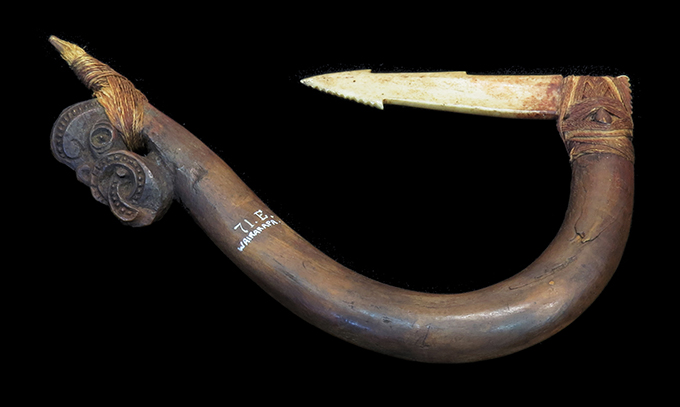
After two years of preparation, Aratoi Museum is pleased to present the largest exhibition of Ngati Kahungunu taonga ever on display. Te Marae o Rongotaketake - Redressing our Kahungunu History fills the entire museum.
The exhibition displays about 200 historical items, including over 70 items from Aratoi's collection, 11 Gottfried Lindauer portraits of Kahungunu rangatira, several intricate carvings in wood, bone, and celluloid, and a 7-metre-long waka. Various taonga are on loan from museums, such as the Fowler Museum in Los Angeles, Auckland Museum, MTG (Napier), Puke Ariki (New Plymouth), Te Manawa (Palmerston North) and Te Papa (Wellington).
The exhibition-as-marae is interspersed with key Kahungunu narratives and uses the powhiri process to guide the visitor through the museum experience, complete with Karanga, Whaikorero, Te o Ha - the coming together - and a Kaumatua Kitchen as a place of learning and socialising.
'It is significant that the exhibition corresponds with the Treaty settlement between Ngati Kahungunu and the Crown, and Aratoi Museum is incredibly honoured that, after a 30-year process, the initialling of the Treaty settlement deed will occur here at our museum, 'says Acting Director Susanna Shadbolt.
The word 'Rongotaketake' in the exhibition title translates as 'enduring peace'. Haami Te Whaiti, curator of the exhibition as well as Treaty negotiator with the Kahungunu, says, 'This peace speaks to our future relationships with the Crown and the community here, just as much as it did to our ancestors back then. The iwi has always been committed to non-violence, and it is well-known that the Wairarapa was "the bloodless province" of Aotearoa.
'The exhibition aims to publicly present the Treaty settlement to both the iwi community and the wider public. The visitor will be enabled to discover and relearn some of the key events that happened during this historical period - the loss and disenfranchisement, as well as the iwi's hopes and aspirations post-settlement.'
Aratoi Museum has sourced taonga nationally and internationally for this large-scale project. The Museum is particularly pleased to exhibit an ornate wahaika (hand weapon) from the Sir Henry Wellcome Collection of the Fowler Museum in Los Angeles. Carved in celluloid by Jacob Heberley (1849-1906), the wahaika originally belonged to Tamahau Mahupuku, of Papawai Marae, and was presented to the 5th Earl of Ranfurly, Governor of New Zealand from 1897-1904, before his departure from Aotearoa.
Among the items on display: waka, wahaika, harakeke waistcoat, several korowai (cloaks), hei tiki, hinaki (eel trap), shark tooth necklace, whale ivory amulets, pounamu spearheads, fish hooks, adzes, adze heads, and needles. Along the highest wall of the museum stands the entire front of a wharenui carved by Te Nahu Haeata for the Te Ore Ore Marae; it has recently been restored.
The exhibition also includes several works from contemporary artists: Tom Donald, Ngataiharuru Taepa and Rongomaiaia Te Whaiti.
Some of the Gottfried Lindauer portraits have just returned from the major exhibition at Auckland Art Gallery. Others have never been displayed in public before.
A full education programme is underway with primary and secondary schools in the region. Artwork generated during the school holiday programme in April is now on display in the Wesley Wing. The museum is also supplying hoe (oars) for children to paint directly in the gallery.

19th century Matau fish hook found in a hollow tree at Pukengaki, carved by Jacob Heberley Collection of Auckland War
Memorial Museum Tamaki Paenga Hira, 71
Homepage image credit:
Korere / Feeding funnel from Pukengaki area, Collection of Auckland War Memorial Museum Tamaki Paenga Hira, 857
Photo by Adam Simpson.